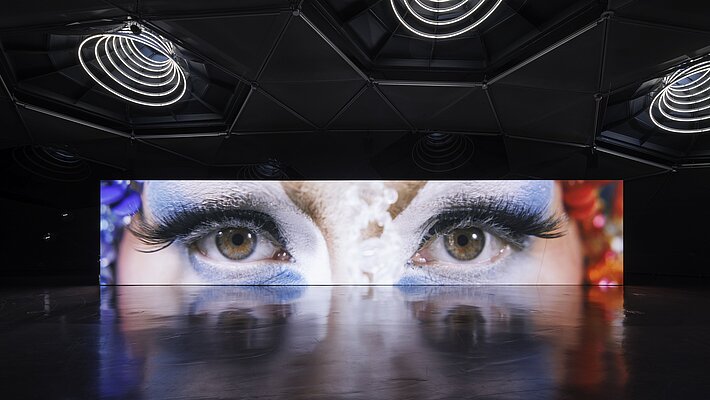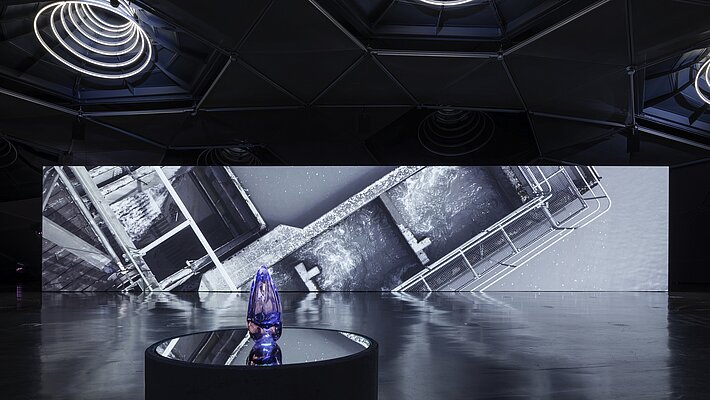|
|
|
|
|
|
Graz, 11 November 2025
In her solo exhibition Waters call me home, Emilija Škarnulytė transforms Space01 at Kunsthaus Graz into a poetic, immersive underwater world of video, light, sound and sculpture. Here, water represents transformation and a fluid archive, while also becoming a metaphor for an inclusive worldview. Škarnulytė intertwines science and mythology, reality and fiction. In the “Cosmic Belly”, Waters call me home creates a sensual call to reorient our perceptual and affective relationship with the planet and the cosmos.
|
|

Emilija Škarnulytė's solo exhibition is on display at Kunsthaus Graz until mid-February 2026, photo: Kunsthaus Graz/J.J. Kucek
|
|
|
|
|
|
|
|
|
|
|
|
The works of Lithuanian artist Emilija Škarnulytė (born in Vilnius in 1987) resemble an inscription into the course of time and the existing and created infrastructures of our planet. The intertwining of science, nature and myth is central to the artist's work. Many of her projects are based on long-term, site-specific scientific research into hidden ecosystems or man-made infrastructures. From the perspective of a future archaeologist, Škarnulytė searches for the ruins and places—from underwater military facilities through to the Milky Way—that we cannot reach or tend to ignore. She is guided by a profound interest in geochronology and an alternative perception of the world from posthuman perspectives. She dives deep into the earth and waters—metaphorically, but also physically speaking—as well as the atomic and the cosmological; she examines layers of earth and water, surfaces and substrates, geological and mythological periods. Oscillating between the micro and macro, her works allude to the hubris of the Anthropocene, which has put humans at the centre of the universe.
Important references for Emilija Škarnulytė's practice include Marija Gimbutas' archaeomythology and Aleksandra Kasuba's artistic and architectural visions. From a deeply (eco-)feminist perspective, she explores visionary practices and the origins of myths for their potential for transformation. Hybrid goddesses, mermaids and serpent beings are recurring elements in her work. For the artist, the mermaid is both an embodiment and an artistic tool—an “extended” body instrument. Through the eyes of a posthuman creature, we can see the indelible traces and scars left by humans in a short period of time.
This becomes especially clear in Æqualia (2023). Here, Škarnulytė glides through six kilometres of the Amazon in the form of a chimera—part dolphin, part mermaid—along the line where the milky Rio Solimões meets the dark waters of the Rio Negro. A drone accompanies her, filming from a bird’s eye view. She is flanked by pink Amazon river dolphins, which protect her from the dangers posed by the river. The Amazon represents a balance that has been thrown off-kilter.
Another work dives into the Baltic Sea, thought to be the body of water on Earth most severely affected by oxygen depletion (hypoxia), and which contains man-made “dead zones” where no higher life can exist. Hypoxia (2023) addresses phenomena that oscillate between scientific fact and science fiction—such as the “Baltic Sea anomaly” and the Lithuanian myth of Jūratė. The legend of Jūratė tells of how the god of thunder, Perkūnas, kills her human lover, causing Jūratė to weep “golden tears” which transform into amber. Amber can still be found along the shores of the Baltic today, or crystallising poetically in Emilija Škarnulytė’s sculpture series If Water Could Weep (Mermaid Tears) (2023–).
|
|

Emilija Škarnulytė transforms the space into an immersive interplay of video, light, sound and artefacts. Her installation invites visitors to delve into the hidden, mystical layers of our world, photo: Ansis Starks
|
|
|
|
|
|
|
|
|
|
|
|
Waters call me home – water as a central element
Škarnulytė's works elude the obvious; they intertwine facts and fiction, real places and mythical figures. Just as multi-layered and volatile as her art is the title she has chosen for her solo show at the Kunsthaus Graz: Waters call me home. Water acts as an abstraction in the exhibition; it becomes the metaphor for a holistic, inclusive worldview. The title is an allusion to the source of life and to the element that the nomadic artist continuously explores. Each artwork serves as a new relational mapping in a visible and sensory manifestation between deep time, our planetary crisis and speculative futures, so calling on the audience to reorient our perceptual and affective relationships with the planet.
Škarnulytė opens up spaces for experience and experimentation that are readapted specifically for each exhibition venue. At the Kunsthaus Graz, videos, sculptures, light and sound merge into a multi-layered rhythm reminiscent of a cosmic underwater landscape. The “Cosmic Belly” of the building is perfectly suited to this kind of immersive spatial experience. A 20-metre-long monolith shows a collage of video works and was devised by Škarnulytė specifically for this site. Light sculptures loom in the space in rhythm with sound, lasers measure the underwater world of the exhibition space. Also presented for the first time—both digitally and in original form—is a new series of drawings in which the artist explores minerals as autonomous matter.
Waters call me home should also be read as an appeal calling on us—whether human, cyborg, goddess or chimera—to integrate ourselves once more into the greater picture. In this sense, Emilija Škarnulytė’s exhibition is an immersive invitation for alternative thinking that shuts out neither science nor mythology, but which recognises our tentacular interconnectedness.
An artist's book will be published by Sternberg Press towards the end of the year. With texts by Emilija Škarnulytė, Filipa Ramos, Chus Martinez, Kate Sutton, Jayne Wilkinson, Alexandra Trost and Katia Huemer.
|
|

‘Waters call me home’ – the title of the exhibition is an allusion to the source of life, photo: Ansis Starks
|
|
|
|
|
|
|
|
|
|
|
|
|
About the artist
Emilija Škarnulytė studied Sculpture at the Brera Academy of Fine Arts in Milan (IT) and holds an MA from the Tromsø Academy of Contemporary Art (NO). She is a founder and currently co-directs Polar Film Lab, a collective for analogue film practice located in Tromsø, Norway, and is a member of the artist duo New Mineral Collective. She works and lives nomadically.
She ist working between documentary and imaginary realms, Škarnulytė makes films, installations, sculptures, drawings, and immersive time-based media that explore the entanglement of the human, the ecological, and the cosmic.
Škarnulytė has presented her work in solo exhibitions at Canal Projects (US), Kunsthall Trondheim (NO) and Tate St Ives (UK). She has exhibited in numerous international group exhibitions, including at MoMA PS1 (US), Louisiana Museum of Modern Art (DK), Mori Art Museum (JP) and Kiasma (FI), and has participated in the Gwangju Biennale (KR), Helsinki Biennale (FI), Vilnius Biennale (LT), and the Henie Onstad Triennial for Photography and New Media (NO). She represented Lithuania at the XXII Triennale di Milano (IT) and in the Baltic Pavilion at the 2018 Venice Architecture Biennale. She is the recipient of the 2019 Future Generation Art Prize and the 2023 Ars Fennica Award.
______________________
Emilija Škarnulytė
Waters call me home
08.11.2025–15.02.2026
Curated by Katia Huemer, Alexandra Trost
Kunsthaus Graz
Lendkai 1, 8020 Graz
www.kunsthausgraz.at
Exhibition views for download and further information can be found at the following link:
Emilija Škarnulytė
______________________
We look forward to your coverage and are happy to answer any questions you may have!
Kind regards
Daniela Teuschler
+43/664/8017-9214, daniela.teuschler@museum-joanneum.at
Stephanie Liebmann
+43/664/8017-9213, stephanie.liebmann@museum-joanneum.at
Eva Sappl
+43/699/1780-9002, eva.sappl@museum-joanneum.at
|
|
|
|
|
|
|
|